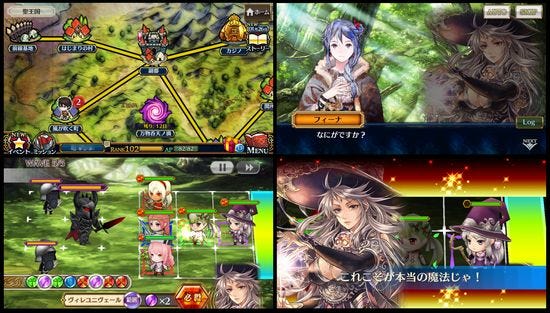(I initially posted this article in my blog LEAP TO THE FUTURE. )
The fact that Sony's smartphone game Fate/Grand Order (abbreviated as FGO) surpassed Nintendo's Pokémon Go must have surprised people in the game industry outside of Japan. According to the AppAnnie's monthly ranking in December (sum of grossing in iOS and android), FGO outperformed the sales of Pokémon Go and was ranked 4th.

FGO has been keeping high rank in the grossing ranking of both AppStore and Google Play since release released in Japan in the summer of 2015. Also, it was released in China by bilibili in the fall of 2016 and soon FGO got large popularity. That was because "Fate" had been recognized widely among China's anime fans through the animation produced by Aniplex (Sony's anime production).

China version of FGO was released in fall 2016
FGO has achieved a great success in both Japan and China, and might have a success even in English-speaking countries, because "Fate" is recognized by anime fans in those countries through Crunchyroll, the American online community which distributes Asian contents including anime, comic, drama and so on.
There are two articles reporting the success of FGO here.
As those articles show, the attention of Western people to FGO has been increasing little by little. Now, everyone knows "Pokémon" or "Mario", but most Western people except anime-fans don't know "Fate" yet. It is the most famous and tremendous popular series among Japan's Otaku-users.
Okay. Let me explain the secret of FGO's popularity and the analysis of game design. By the way, I spent more than 15 thousand dollars on this game! I confess that I'm a OVER-PAYING user.
What is Fate/Grand Order?
FGO is a brilliant fusion of two genres, JRPG and visual novel, which are the representative of Japan's story-driven game, and it is one extreme in the history of Japanese story-driven games. Recalling now, the year 2016 was an incredibly fruitful year for JRPG where FGO accomplished the finale of episode1 and both of Persona 5 and Final Fantasy 15 were released.
Legendary scenario writer Kinoko Nasu and two writers wrote all stories, attracting attention from many Otaku-users before the release. It is no doubt that he is the most popular and GREAT scenario writer in visual novel industry. He had written a few indie-novel and then developed a few legendary indie visual novels like Tsukihime (it means Moon Princess), Fate and others.

Legendary doujin-indie visual novel ”Tsukihime"
His indie brand, TYPE-MOON was in charge of scenario writing and character design, and DELiGHTWORKS developed client application and server program.
To put it simply, the story is that you should restore the erroneous history, summoning the ancient and east-west heroes in human history such as King Arthur, Girgamesh, Jeanne d'Arc, Alexander the Great, Siegfried. You visit the seven past eras from ancient to modern, and solve the calamity that seems to be the cause of the destruction of history of humanity, summoning "Servants", the personification of a renowned figure in history.

There are many renowned figures in human history.
(King Arthur, Girgamesh, Jeanne d'Arc, Alexander the Great)
For instance, the seven eras in which player adventure are as follows: In one era, the executed Jeanne d'Arc got resurrected and occupied France, using the wicked dragons. In another era, the Roman successive emperors got resurrected and invaded the Roman dominated by Emperor Nero.
You can summon more than 100 "Servants" with their narrative background and distinctive features in the battle system. How do you make them companions? Of course, rolling a Gacha.

You can usually get servants by rolling a Gacha.
Left: Gacha, Right: List of Servants
Each servant has four stages of illustration, voice, battle graphics, background setting text, episode demo. There are five levels of Servant's rarity, and as rarity rises, a Servant has strong status parameters like HP and the power of attack.
Game design of FGO
FGO is heavily influenced by the game design of Sega's Chain Chronicle, which is a story-driven smartphone RPG that has a huge deep scenario and a tower-defense type of battle system. Instead of tower-defense, FGO adopted a side-view battle system combined of turn based traditional JRPG battle and TCG-like battle.

Sega's smartphone RPG "Chain Chronicles" has a visual-novel-like demo
and tower-diffence battle system.
For each era, the stage of adventure is represented by one map. Initially, only one site is open. You complete the main story quest on the site, and so the next quest will be opened ( or the next site will be opened).

For each era, the stage of adventure is represented by one map
(Left: France in 1431, Right: Rome in 0060)
You execute the quest consuming the AP, and see the visual-novel-like demo. Options are sometimes displayed, but regardless of which choice you select, the main story will not change significantly. You can skip or check the log freely.

Left: various characters talking in the visual-novel-like demo
Right Up: selecting the choices Right Down: checking the log
After the visual novel demo, you enter into battle. It is the complex battle combined both of traditional JRPG command battle and strategy like TCG. You beat all enemies to acquire Master's experience, affinity with your Servants, QP (in-game money) , materials. Dropped material and QP are necessary to strengthen Servants.

Battle combined turn based JRPG and strategy like TCG
The battle system is complexed and deep, but I would like to describe them later.
View from aspect of visual novel
FGO is the latest franchise titles based on Nasuverse, and has attractive points both aspect of visual novel and JRPG. By the way, What is Fate series? First, I will explain it in detail.
The Beginning
TYPE-MOON's "Fate" started from the visual novel Fate / stay night (for PC) in 2004. The visual novel has a huge story that spans over 50 hours of play time. It set a sales



































